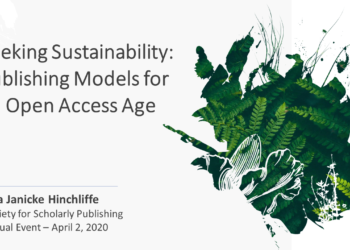Over the last decade, longstanding scholarly publishers have been metamorphizing before our eyes, shedding old ways of doing business and taking up broad initiatives to reinvent what publishers do and why they matter. Many of these mutations are motivated by the pace of digital disruptions in our globally networked information economy. In relative terms, the last decade’s rate of change in how we consume and create information outpaces the previous hundred years.
Our industry has been wrestling with many challenges related to technological disruptions and demands for publishing innovations for some time now. On the surface, the work required to bring print journals into the digital world appears to be largely technological. However, a comprehensive and lasting transformation from a print-centric business to a digital-first business requires equal investment in the technological as well as the cultural. Digital innovations are more of a human science than computer science.

In a recent panel during the virtual London Book Fair, Sam Herbert of 67 Bricks introduced the discussion topic of digital transformation as a “highly emotive subject.” Sam was joined by Harriet Bell of Emerald Publishing and Scott Williams of De Gruyter, who shared their experiences with broad-scale strategic reorientations of the organizations’ epicenters. Although each has uniquely designed plans and visions for recalibrating their businesses toward fully digital publishing products and services, both Harriet and Scott spoke of the distinctly human nature of their digital renovations.
More than a website rebuild
The digital transformation initiatives at Emerald and De Gruyter are aiming for wholly new approaches to scholarly publishing, revising many processes end-to-end, and shifting the center of gravity from the scale of print to the vastness of digital publishing. While redesigning interfaces or modernizing content management systems often are major projects within such a transformational initiative, the scope of this work transcends that of a website rebuild.
The publishing processes built up over generations around print distribution served specific purposes and ensured decades of reliable profits and stable success. However, many of these organizational structures and workflows do not translate to the digital world. Publishers are being challenged to think beyond a single journal article or book series, to consider platform-wide architecture. Harriet reflected on the work required to shift Emerald’s collective mindset away from analog dissemination, with metrics in the hundreds or thousands, to the digital scale of millions of users with immediate demands on your terabytes of data. “The difference in thinking is really phenomenal,” she said. This is one of the reasons why Emerald is investing in data literacy, sales and marketing automation, and a single view of the customer journey.
The magnitude of such digital transformations is also a matter of ambition. Like many academic publishers, Harriet explains how Emerald’s digital journey began with initially aiming to become a digitized publisher. However, this is not the same as building a truly digital enterprise, which has regular, direct engagement with readers and authors, is invested in delivering personalized experiences, and aims to add new value to the research lifecycle.
For Scott, overhauling De Gruyter starts with a significant mindset shift that places the consumer, and their information experiences, at the heart of all decisions. “The fact is, no one internally is as important as the people externally,” which sometimes makes the platform team unpopular with those who want to vet all changes to digital products and services. In part, both publishers see their initiatives as an effort to future-proof their organizations to survive the ongoing and sometimes volatile changes in publishing technologies and research practices.
Change is emotional
Asking colleagues to shift their mental focus and operational priorities poses major challenges to institutionalized norms and success metrics. This can cause anger and frustration, when processes, workflows, and behaviors that were valued in the past are now changing to deliver in a new environment. Disrupting traditional priorities and upending age-old workflows has been a reality for publishers of all types for many years now. And the changes just keep on coming!
Like it or not, when faced with pressure to change, most folks choose fight-or-flight responses. Therefore, a key step of reorganizations like those underway at Emerald and De Gruyter is acknowledging the cultural and individual challenges that inevitably arise. Teams must be inspired to venture into uncharted territories and dedicate themselves to a shared mission, or a “north star” everyone can navigate toward. Overhauling organizations with centuries-old workflows and staff roles demands something of each employee: a willingness to be vulnerable, to learn, to experiment, to admit flaws.
Mistakes and missteps are necessary elements of any transformational journey. Scott believes acknowledging when you get things wrong might be the most important lesson. “Screw up as quickly as you can with the least amount of damage,” he said. The panel agreed, without mistakes, we do not learn, and therefore we do not grow. Plain and simple: digital transformation requires honest collaboration, healthy communication, careful listening, and the ability to set aside personal agendas and comfortable ruts.
A common misconception is that a digital publishing overhaul requires high-tech skills and fresh talent from outside the industry. In fact, Scott and Harriet have found the winning formula to be 80% what you think and 20% what you know. More than hiring for mad skills with analytics or web design, publishers looking to transform their businesses should be investing in staff that demonstrate ingenuity, curiosity, bravery, grit, and thirst for innovation. Technical skills can be easily taught, but a good attitude cannot.
Inspiring innovative attitudes and resilience in the face of change is the killer app of successful digital transformations. Acknowledging that there will be moments of discomfort and uncertainty, digital-first publishers invite their teams to pilot new processes, trial new roles, and consider new ways of achieving their goals. This requires a level of buy-in to the core mission, which for both Emerald and De Gruyter has been a product design shift away from committee-driven enhancement requests toward iterative, customer-centric development.
They agree these sorts of changes can be personally challenging and mentally draining. Cultural changes require developing a degree of empathy for those across the business and being willing to stretch themselves. Scott explained there is significant emotional work involved in such digital revolutions, which is often a matter of learning to be comfortable with discomfort and uncertainty: “there is a restlessness around iterative improvements.”
Positive feedback loops and quick wins
The case studies provided by Emerald and De Gruyter prove that this is no one right way to transform a print-centric business into an experience-centric one. De Gruyter adopted a somewhat gradual approach, starting with simple, well-defined, yet high-value development goals with clear metrics for success. Scott has found that proof-of-concept projects were good ways to quickly demonstrate value to the business and earn trust among stakeholders.
Emerald adopted a big-bang approach of implementing many revised processes as well as product changes in a short timeframe. They moved away from third-party hosting and embraced the challenges of delivering products and services directly to their readers and authors. Emerald brought their platform entirely in-house – a new interface, new content management system, new customer database – all at once.
This aspiration of full-scale business transformation “created some urgency and a vision that everyone could get behind, and get excited about,” Harriet reflected. Looking back, she cautions publishers to not be afraid of bumps along the way. You learn from the false starts and often learn how to cut your losses more quickly when something does not work. She has learned that consensus building internally can be at the expense of incremental delivery out to the customer, who are really going to tell you whether this is right or not.
Whether gradual or big-bang, Harriet and Scott agree that their biggest discovery was not technological in nature. Instead, the game changer was harnessing teamwork to acknowledge what does not work and to quickly pivot when a process, product, or service is not serving the primary vision. Keeping systems iterative and processes nimble allows an organization to respond to evolving dynamics in real-time, rather than retaining a defensive or responsive crouch, increasing the group’s resistance to change.
Embracing change
For an industry driven by what Scott calls “power-point-ism,” where organizational fact is often established by polished slide presentations that can obscure deeper strategic dysfunction, rapid change and cultural evolution do not come easy. Today’s industry dynamics demand we embrace fluid organizational identities and visions for what value publishers provide so that we are more able to quickly pivot as market forces change. However, each stakeholder will interpret that vision slightly differently. No matter how snazzy the development roadmap or how hard we work toward a singular shared vision for how a website should work, a disconnect can develop between the overarching narrative and the reality of what is being built. Success lies in agreeing to the root problems and then committing to the disciplined cycles needed to arrive at an innovative solution.
These evolutions are possible for all types and sizes of organizations, even if the paths are unique. In practical terms, some will do best with trial projects and some will need sweeping changes. Either way, the willingness to iterate and pivot quickly is the key. Scott believes “all empires fail eventually, however those systems with regular improvements will succeed.”
Digital transformations remind us that, regardless of industry, all work happens in the context of relationships. Productive organizational cultures foster fellowship and collective investments toward a shared vision, over ego or individual gains. Because of the very human nature of grappling with change, the panel agreed that hiring a diverse workforce with the right attitudes is the best way forward. But Scott advises publishers to be ready for the technical challenges as well as the cultural awakening: “Digital transformation reveals more about a person than anyone is prepared to admit.”
Acknowledgments
Many thanks to Harriet Bell of Emerald Publishing, Scott Williams of De Gruyter, and Sam Herbert at 67 Bricks for sharing their time and experiences with The Scholarly Kitchen. And special thanks to Esther Harris of 67 Bricks for the inspiration!
Discussion
6 Thoughts on "Digital Transformation Requires Cultural Evolution"
Thanks Lettie, Sam, Harriet, and Scott, thoughtful and to the point
Thank you for this excellent article – every paragraph speaks to my lived experience. I think this is even more fascinating and challenging for publishers who remain grounded in print publishing while embracing what digital can offer our readers – we are in some senses trying to do, and be, both.
“More than hiring for mad skills with analytics or web design, publishers looking to transform their businesses should be investing in staff that demonstrate ingenuity, curiosity, bravery, grit, and thirst for innovation. Technical skills can be easily taught, but a good attitude cannot.” This in particular is so critical – not so much skills as mindset.
I will bookmark this article!
Many thanks, Kim, for your comment — so glad this piece resonated with you!
As I was writing this up, I reflected on the “soft skills” of communication, trust-building, empathy, etc., which in many circles (often male-dominated high-tech ones) are still seen as nice-to-have and not critical. Perhaps this is changing now, and I hope more execs adopt the type of cultural and emotional sensitivity Harriet and Scott bring to their organizations!



